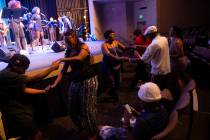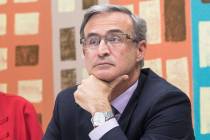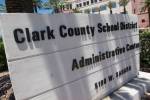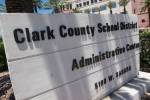Southern Nevada colleges gain under new funding formula
The chancellor's proposal to rewrite the formula used to fund colleges and universities could mean huge gains for the institutions in Southern Nevada.
The proposal, released to the higher education system's Board of Regents and a legislative committee on Friday, calls for allocating $13 million more per year to the southern colleges and universities.
That figure assumes that the higher ed system's overall budget remains flat. In addition to the gains in funding for the southern institutions, the northern ones would all see less money, particularly the rural community colleges.
While saying the proposal is not perfect, UNLV President Neal Smatresk praised it as a giant step in the right direction. He has long complained that the university is underfunded.
"This formula is clearly a major improvement on the last formula," Smatresk said. "It goes a long way towards creating equity for the colleges and universities. It is a solid proposal for the system of higher education, and it's a solid proposal for giving incentives in the future."
UNLV would stand to gain about $3 million a year in funding, slightly more than a 1 percent bump when general fund dollars and tuition and fees are counted.
The College of Southern Nevada, by far the largest institution in the state and one that is acknowledged by nearly everyone to be chronically underfunded, would gain $7 million per year. That would be a nearly 5 percent increase.
CSN is on spring break this week. School officials couldn't be reached late Friday.
Tracy Sherman, the faculty senate chair at CSN, said she was pleased but guarded about Chancellor Dan Klaich's proposal.
"Obviously, we would be more comfortable if we had more money, with what was more in line with the number of students we had," she said. "More appreciative that we have not been funded appropriately for a long time."
She said the overall funding of the higher education system should increase, not just CSN's share of a static pie.
"We all want to be funded appropriately," she said, speaking about conversations with other faculty senate chairs. "We all want to be funded equitably. Fairly. We don't like the idea that we will be pitted against each other."
The largest increase at any institution would come for Nevada State College, which opened a decade ago and has about 3,000 students. NSC would see its budget jump $3 million, an increase of more than 15 percent.
Robin Herlands, a biology professor and the NSC faculty senate chair, said the college has been struggling to keep up with growing enrollments while seeing its budget decline in recent years.
"The increase in funding to Nevada State is in some ways a recognition of the success we've had with incredibly limited resources," she said.
"I applaud the effort to try to find a formula that really values equity and transparency."
Under Klaich's proposal -- which would have to be approved the Board of Regents, a legislative committee, the Legislature and the governor before becoming reality -- the University of Nevada, Reno, would see a $1.2 million annual drop in funding, a drop of less than 1 percent.
Western Nevada and Great Basin community colleges would see drops in funding of 26 percent and 31 percent, respectively, while Truckee Meadows Community College would see a 6 percent drop.
Klaich said he wanted to stress that the formula rewrite should not be seen as a collection of winners and losers.
He said the large cuts under the proposal "would have to be mitigated, obviously," and that, like others, he wants to see the higher education system's overall budget increase.
"We're not saying this is adequate funding or this is where funding should be," he said.
The pending rewrite of the funding formula has been a dream of the state's higher education leaders for years. The current formula, in place for more than a decade, is seen as too complicated for most people to understand.
It also has been criticized by some of Southern Nevada's higher education leaders for sending half of all the state's higher education funding to Northern Nevada institutions despite the fact that nearly three-fourths of the students are in Southern Nevada.
To get the numbers in his proposal, Klaich plugged the current year's state general fund allocation -- $362 million -- and the tuition and fees collected this year into his proposal.
The new proposal rewards growth in graduation rates, rather than growth in enrollment, and now would fund the research missions at the universities, which are much more prominent than they were in years past.
It also allows each of the institutions to keep the tuition and fees collected there. Currently, that money is essentially subtracted from whatever state tax money the institution would get. This is a high-profile problem at UNLV, which has the most nonresident students in the state.
Nonresidents pay more than Nevada residents to attend a public college or university here.
The new proposal, whether it is Klaich's or one pitched by a consultant or some hybrid, probably will include a provision to fund university research, and would reward performance, generally measured by the number of graduates each institution produces.
There has been widespread agreement in Nevada that the formula needed a rewrite.
Contact reporter Richard Lake at rlake@review journal.com or 702-383-0307.
FUNDING FORMULA
Gains or increases in annual funding under a proposed rewrite of Nevada's higher education funding formula.
Losses are in parenthesis:
UNR (1,264,930)
UNLV 3,197,979
College of Southern Nevada 7,034,069
Nevada State College 3,028,141
Great Basin College (4,566,160)
Truckee Meadows Community College (2,884,371)
Western Nevada College (4,544,728)
For the full proposal, go to
www.nevada.edu/funding























